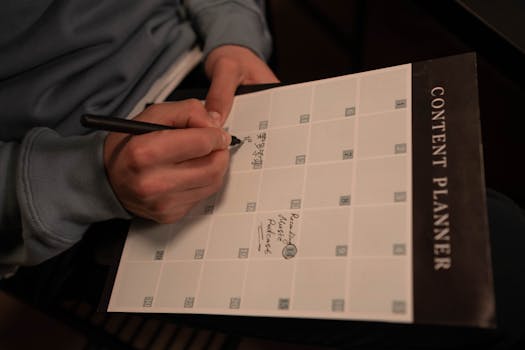
Introduction

In today’s fast-paced world, effective time management is crucial for success, both in professional and personal realms. With distractions everywhere and responsibilities piling on, mastering your schedule can make a significant difference in achieving your goals. This blog post provides insightful strategies for efficient time management that you can implement in your daily routine.
Understanding Time Management

Before diving into specific strategies, it’s important to understand what time management actually entails. Time management can be defined as the method of using one’s time effectively or productively. It incorporates various techniques ranging from proper planning and prioritization to the elimination of wasted time.
Despite the common perception that only highly busy people struggle with time management, this skill is a critical aspect for individuals in all walks of life, from students balancing studies and extracurriculars to professionals managing work and home life.
1. Identifying Goals and Priorities

The first step towards effective time management is identifying your short-term and long-term goals. What are you trying to achieve? Setting clear, actionable goals provides the roadmap for your time management journey.
Smart Goal Setting
Employ the SMART criteria for effective goal setting. Your goals should be:
- Specific: What do you want to accomplish?
- Measurable: How will you measure your success?
- Achievable: Is this goal realistically achievable?
- Relevant: Does this goal align with your overall objectives?
- Time-bound: What is the deadline for your goal?
By having well-defined goals, it becomes easier to sort out tasks that contribute positively and those that are time-wasters. Regularly reviewing these goals helps you gauge your progress and adjust your focus as necessary.
2. Planning and Prioritization

Once you have your goals, effective planning and prioritization are key components of managing your time wisely.
Planning with a Calendar
Believe it or not, a simple calendar can be a game changer. Utilize digital tools like Google Calendar or productivity apps to plan your activities and meetings. Highlight important deadlines, upcoming events, and blocking off periods for dedicated work time avoids scheduling conflicts and ensures you allocate time appropriately.
Creating a To-Do List
A daily or weekly to-do list can greatly enhance your effectiveness. Consider categorizing tasks into:
1. Urgent and important: Do these tasks today.
2. Important but not urgent: Plan to finish these soon enough.
3. Urgent but not important: Delegate if possible.
4. Neither urgent nor important: Eliminate these tasks.
3. Overcoming Procrastination

Procrastination is a foe that many face while managing their time. Here are strategies to overcome it effectively.
The Pomodoro Technique
This well-known technique involves working in focused bursts (typically 25 minutes long) followed by short breaks (5 minutes). After a few cycles, a longer break can be employed. It encourages productivity by reducing burnout.
Accountability Partner
Having someone to hold you accountable can significantly reduce procrastination. Share your goals with an accountable friend or colleague, and check in with one another regularly to discuss the progress you’ve made.
4. Eliminating Distractions

The ability to focus deeply greatly enhances productivity; eliminating distractions is crucial in nurturing an undisturbed work environment. Here are some tips:
Designed Work Environment
Create a structured workstation that encourages focus. This can range from eliminating clutter, utilizing noise-canceling headphones, or employing apps that block distracting sites during work hours.
Time Blocking
By using time-blocking methodologies where specific chunks are allocated for particular tasks, technology usage can be cut down during targeted times, ensuring production is maximized.
5. Continuous Assessment and Flexibility

Finally, ongoing assessment of your strategies is vital. What worked last month might not yield the same results as your circumstances change. Regularly evaluating your approach supports continuous improvement within time-use practices.
Reflect and Adjust
Spending a little time each week reflecting on what you accomplished and what fell through helps clarify habits to embrace or drop. Be adaptable—if one strategy fails, willing to explore another can be the key to continual development.
Conclusion

Mirroring the importance of aesthetic beauty involves everything light in our life—including how we manage our most precious resource, time. Crafting effective time management strategies promotes productivity improvement and enhances overall well-being.
Through setting clear goals, actively planning, prioritization, overcoming procrastination, and continuously assessing your methods, you’d usher your journey toward superior time efficacy—achieving even more within your enthused timeline.
Takeaways

- Effective time management begins with defining and understanding your goals.
- Planning and prioritization improve day-to-day task execution.
- Skinning the skin off procrastination using beneficial practices can liberate creative bits.
- Only suit unto sustainable and refinable methods will likely yield long-lasting time management efficiencies!
References







